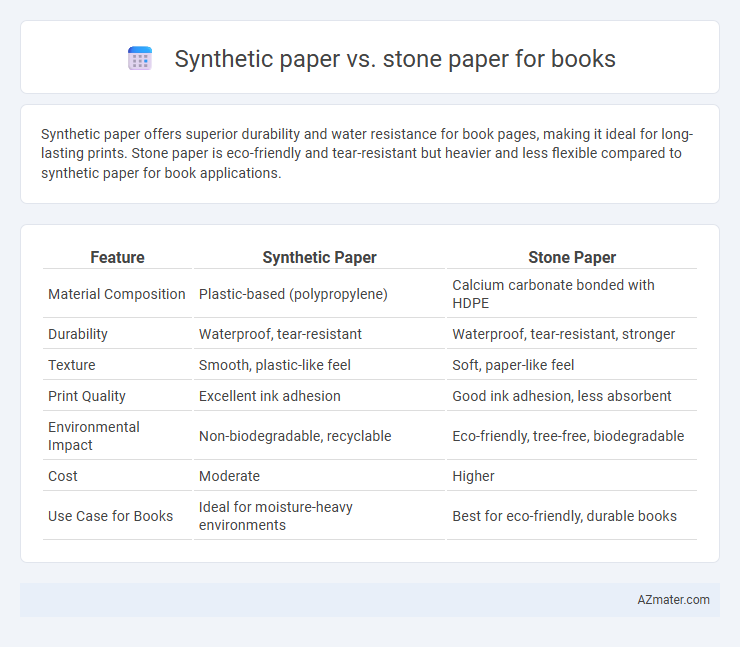Synthetic paper offers superior durability and water resistance for book pages, making it ideal for long-lasting prints. Stone paper is eco-friendly and tear-resistant but heavier and less flexible compared to synthetic paper for book applications.
Table of Comparison
| Feature | Synthetic Paper | Stone Paper |
|---|---|---|
| Material Composition | Plastic-based (polypropylene) | Calcium carbonate bonded with HDPE |
| Durability | Waterproof, tear-resistant | Waterproof, tear-resistant, stronger |
| Texture | Smooth, plastic-like feel | Soft, paper-like feel |
| Print Quality | Excellent ink adhesion | Good ink adhesion, less absorbent |
| Environmental Impact | Non-biodegradable, recyclable | Eco-friendly, tree-free, biodegradable |
| Cost | Moderate | Higher |
| Use Case for Books | Ideal for moisture-heavy environments | Best for eco-friendly, durable books |
Introduction to Synthetic Paper and Stone Paper
Synthetic paper is a durable, water-resistant material made from polypropylene that offers excellent print quality and tear resistance, making it an ideal choice for books requiring longevity and vibrant visuals. Stone paper, composed of calcium carbonate bonded with non-toxic resin, is eco-friendly, waterproof, and provides a smooth texture, enhancing the tactile reading experience while reducing reliance on wood pulp. Both materials present sustainable alternatives to traditional paper but differ in composition, texture, and environmental impact.
Composition and Manufacturing Process
Synthetic paper is primarily composed of polypropylene or polyethylene polymers, produced through extrusion and calendaring processes that create a smooth, durable surface resembling traditional paper. Stone paper, made from calcium carbonate bonded with high-density polyethylene (HDPE), is manufactured without water or wood pulp by compressing ground stone powder into sheets, resulting in a waterproof and tear-resistant material. Both materials offer eco-friendly alternatives to conventional paper, with synthetic paper emphasizing polymer-based production, while stone paper highlights mineral-based composition and waterless manufacturing.
Environmental Impact and Sustainability
Synthetic paper and stone paper both offer eco-friendly alternatives to traditional wood pulp paper, with synthetic paper typically made from polypropylene and stone paper derived from calcium carbonate bonded with resin. Stone paper production uses significantly less water and energy, emits fewer greenhouse gases, and involves no bleach or acid, making it more sustainable in terms of environmental impact. Synthetic paper is durable and recyclable but relies on petroleum-based materials, whereas stone paper's biodegradable properties and reduced resource consumption position it as a more sustainable choice for eco-conscious book printing.
Durability and Longevity in Book Applications
Synthetic paper offers superior tear resistance and water-proof qualities, making it highly durable for book applications exposed to harsh environments. Stone paper, made from calcium carbonate bonded with resin, provides excellent resistance to moisture and tearing, ensuring long-lasting pages without yellowing or degradation. Both materials extend book longevity beyond conventional paper, with synthetic paper generally outperforming stone paper in UV resistance and abrasion durability.
Print Quality and Ink Compatibility
Synthetic paper offers superior print quality for books due to its smooth surface, which enhances detail sharpness and color vibrancy using standard inkjet and laser printers. Stone paper, while durable and water-resistant, can present challenges with ink adhesion and drying time, often requiring specialized inks to avoid smudging or fading. Both materials demand careful consideration of print technology compatibility to ensure optimal ink bonding and longevity in book production.
Texture, Feel, and Reader Experience
Synthetic paper offers a smooth, matte texture that mimics traditional paper, providing a familiar feel that enhances readability and reduces eye strain during extended reading sessions. Stone paper features a slightly waxy, more durable surface with a silky finish, delivering water resistance and tear proof qualities that improve longevity but can feel less natural to touch. Readers tend to prefer synthetic paper for the comfortable tactile experience of printed text, while stone paper appeals to those valuing robustness and eco-friendly water resilience in books.
Cost Comparison: Synthetic vs Stone Paper
Synthetic paper typically costs more per sheet than stone paper due to its plastic-based materials and higher manufacturing energy demands. Stone paper, made primarily from calcium carbonate and a small percentage of resin, offers a more cost-effective alternative with lower raw material expenses and reduced environmental processing fees. For book production, choosing stone paper can result in significant savings on material costs while maintaining durability and print quality.
Water and Tear Resistance
Synthetic paper offers superior water resistance due to its polypropylene composition, preventing ink bleed and maintaining print clarity even when wet. Stone paper, made from calcium carbonate bonded with high-density polyethylene, provides excellent tear resistance and durability, making it less prone to ripping under stress. Both materials outperform traditional paper in moisture-prone environments, with synthetic paper excelling in water exposure and stone paper offering enhanced strength against physical damage.
Recycling and Disposal Considerations
Synthetic paper, typically made from polypropylene, offers high durability and water resistance but poses recycling challenges due to its plastic composition, requiring specialized facilities to separate it from traditional paper waste. Stone paper, composed mainly of calcium carbonate bonded with non-toxic resin, is more environmentally friendly, as it is photodegradable and can be recycled through conventional plastic recycling streams. Both materials require careful consideration in disposal to minimize environmental impact, with stone paper generally favored for easier recycling and reduced chemical use.
Choosing the Right Paper for Books
Synthetic paper, typically made from polypropylene, offers high durability, water resistance, and tear-proof qualities, making it ideal for books used in harsh environments or outdoor reading. Stone paper, produced from calcium carbonate bonded with resin, provides an eco-friendly alternative with a smooth texture and excellent opacity, enhancing print quality while being recyclable and biodegradable. Choosing the right paper depends on balancing factors like environmental impact, durability, print clarity, and cost, with synthetic paper favored for longevity and stone paper preferred for sustainability.

Infographic: Synthetic paper vs Stone paper for Book
 azmater.com
azmater.com